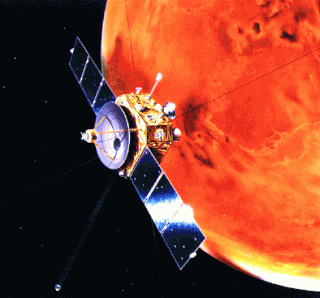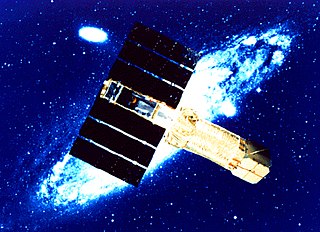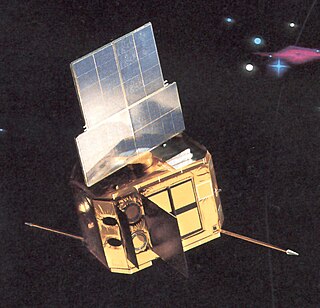
The Chandra X-ray Observatory (CXO), previously known as the Advanced X-ray Astrophysics Facility (AXAF), is a Flagship-class space telescope launched aboard the Space ShuttleColumbia during STS-93 by NASA on July 23, 1999. Chandra was sensitive to X-ray sources 100 times fainter than any previous X-ray telescope, enabled by the high angular resolution of its mirrors. Since the Earth's atmosphere absorbs the vast majority of X-rays, they are not detectable from Earth-based telescopes; therefore space-based telescopes are required to make these observations. Chandra is an Earth satellite in a 64-hour orbit, and its mission is ongoing as of 2024.

XMM-Newton, also known as the High Throughput X-ray Spectroscopy Mission and the X-ray Multi-Mirror Mission, is an X-ray space observatory launched by the European Space Agency in December 1999 on an Ariane 5 rocket. It is the second cornerstone mission of ESA's Horizon 2000 programme. Named after physicist and astronomer Sir Isaac Newton, the spacecraft is tasked with investigating interstellar X-ray sources, performing narrow- and broad-range spectroscopy, and performing the first simultaneous imaging of objects in both X-ray and optical wavelengths.

Nozomi was a Japanese Mars orbiter that failed to reach Mars due to electrical failure. It was constructed by the Institute of Space and Astronautical Science, University of Tokyo and launched on July 4, 1998, at 03:12 JST with an on-orbit dry mass of 258 kg and 282 kg of propellant. The Nozomi mission was terminated on December 31, 2003.

The Compton Gamma Ray Observatory (CGRO) was a space observatory detecting photons with energies from 20 keV to 30 GeV, in Earth orbit from 1991 to 2000. The observatory featured four main telescopes in one spacecraft, covering X-rays and gamma rays, including various specialized sub-instruments and detectors. Following 14 years of effort, the observatory was launched from Space Shuttle Atlantis during STS-37 on April 5, 1991, and operated until its deorbit on June 4, 2000. It was deployed in low Earth orbit at 450 km (280 mi) to avoid the Van Allen radiation belt. It was the heaviest astrophysical payload ever flown at that time at 16,300 kilograms (35,900 lb).

BepiColombo is a joint mission of the European Space Agency (ESA) and the Japan Aerospace Exploration Agency (JAXA) to the planet Mercury. The mission comprises two satellites launched together: the Mercury Planetary Orbiter (MPO) and Mio. The mission will perform a comprehensive study of Mercury, including characterization of its magnetic field, magnetosphere, and both interior and surface structure. It was launched on an Ariane 5 rocket on 20 October 2018 at 01:45 UTC, with an arrival at Mercury planned for on 5 December 2025, after a flyby of Earth, two flybys of Venus, and six flybys of Mercury. The mission was approved in November 2009, after years in proposal and planning as part of the European Space Agency's Horizon 2000+ programme; it is the last mission of the programme to be launched.

Yohkoh, known before launch as Solar-A, was a Solar observatory spacecraft of the Institute of Space and Astronautical Science (Japan), in collaboration with space agencies in the United States and the United Kingdom. It was launched into Earth orbit on August 30, 1991 by the M-3SII rocket from Kagoshima Space Center. It took its first soft X-ray image on September 13, 1991, 21:53:40, and movie representations of the X-ray corona over 1991-2001 are available at the Yohkoh Legacy site.

The Advanced Satellite for Cosmology and Astrophysics was the fourth cosmic X-ray astronomy mission by JAXA, and the second for which the United States provided part of the scientific payload. The satellite was successfully launched on 20 February 1993. The first eight months of the ASCA mission were devoted to performance verification. Having established the quality of performance of all ASCA's instruments, the spacecraft provided science observations for the remainder of the mission. In this phase the observing program was open to astronomers based at Japanese and U.S. institutions, as well as those located in member states of the European Space Agency.

The European X-ray Observatory Satellite (EXOSAT), originally named HELOS, was an X-ray telescope operational from May 1983 until April 1986 and in that time made 1780 observations in the X-ray band of most classes of astronomical object including active galactic nuclei, stellar coronae, cataclysmic variables, white dwarfs, X-ray binaries, clusters of galaxies, and supernova remnants.

The INTErnational Gamma-Ray Astrophysics Laboratory (INTEGRAL) is a space telescope for observing gamma rays of energies up to 8 MeV. It was launched by the European Space Agency (ESA) into Earth orbit in 2002, and is designed to provide imaging and spectroscopy of cosmic sources. In the MeV energy range, it is the most sensitive gamma ray observatory in space. It is sensitive to higher energy photons than X-ray instruments such as NuSTAR, the Neil Gehrels Swift Observatory, XMM-Newton, and lower than other gamma-ray instruments such Fermi and HESS.

The Solar Orbiter (SolO) is a Sun-observing probe developed by the European Space Agency (ESA) with a National Aeronautics and Space Administration (NASA) contribution. Solar Orbiter, designed to obtain detailed measurements of the inner heliosphere and the nascent solar wind, will also perform close observations of the polar regions of the Sun which is difficult to do from Earth. These observations are important in investigating how the Sun creates and controls its heliosphere.

An X-ray telescope (XRT) is a telescope that is designed to observe remote objects in the X-ray spectrum. X-rays are absorbed by the Earth's atmosphere, so instruments to detect X-rays must be taken to high altitude by balloons, sounding rockets, and satellites.

The Russian Space Research Institute is the leading organization of the Russian Academy of Sciences on space exploration to benefit fundamental science. It was formerly known as the Space Research Institute of the USSR Academy of Sciences. It is usually known by the shorter name Space Research Institute and especially by the initialism IKI.

The International Astrophysical Observatory "GRANAT", was a Soviet space observatory developed in collaboration with France, Denmark and Bulgaria. It was launched on 1 December 1989 aboard a Proton rocket and placed in a highly eccentric four-day orbit, of which three were devoted to observations. It operated for almost nine years.

Aditya-L1 is a coronagraphy spacecraft for studying the solar atmosphere, designed and developed by the Indian Space Research Organisation (ISRO) and various other Indian Space Research Institutes. It is orbiting at about 1.5 million km from Earth in a halo orbit around the Lagrange point 1 (L1) between the Earth and the Sun, where it will study the solar atmosphere, solar magnetic storms, and their impact on the environment around the Earth.

Euclid is a wide-angle space telescope with a 600-megapixel camera to record visible light, a near-infrared spectrometer, and photometer, to determine the redshift of detected galaxies. It was developed by the European Space Agency (ESA) and the Euclid Consortium and was launched on 1 July 2023 from Cape Canaveral in Florida.

The International X-ray Observatory (IXO) is a cancelled X-ray telescope that was to be launched in 2021 as a joint effort by NASA, the European Space Agency (ESA), and the Japan Aerospace Exploration Agency (JAXA). In May 2008, ESA and NASA established a coordination group involving all three agencies, with the intent of exploring a joint mission merging the ongoing XEUS and Constellation-X Observatory (Con-X) projects. This proposed the start of a joint study for IXO. NASA was forced to cancel the observatory due to budget constraints in fiscal year 2012. ESA however decided to reboot the mission on its own developing Advanced Telescope for High Energy Astrophysics as a part of Cosmic Vision program.

Solar wind Magnetosphere Ionosphere Link Explorer (SMILE) is a planned joint venture mission between the European Space Agency and the Chinese Academy of Sciences. SMILE will image for the first time the magnetosphere of the Sun in soft X-rays and UV during up to 40 hours per orbit, improving our understanding of the dynamic interaction between the solar wind and Earth's magnetosphere. The prime science questions of the SMILE mission are

The Space Variable Objects Monitor (SVOM) is a small X-ray telescope satellite developed by China National Space Administration (CNSA), Chinese Academy of Sciences (CAS) and the French Space Agency (CNES), launched on 22 June 2024.

Student Nitric Oxide Explorer, was a NASA small scientific satellite which studied the concentration of nitric oxide in the thermosphere. It was launched in 1998 as part of NASA's Explorer program. The satellite was the first of three missions developed within the Student Explorer Demonstration Initiative (STEDI) program funded by the NASA and managed by the Universities Space Research Association (USRA). STEDI was a pilot program to demonstrate that high-quality space science can be carried out with small, low-cost free-flying satellites on a time scale of two years from go-ahead to launch. The satellite was developed by the University of Colorado Boulder's Laboratory for Atmospheric and Space Physics (LASP) and had met its goals by the time its mission ended with reentry in December 2003.
Transient High-Energy Sky and Early Universe Surveyor (THESEUS) is a space telescope mission proposal by the European Space Agency that would study gamma-ray bursts and X-rays for investigating the early universe. If developed, the mission would investigate star formation rates and metallicity evolution, as well as studying the sources and physics of reionization.
















